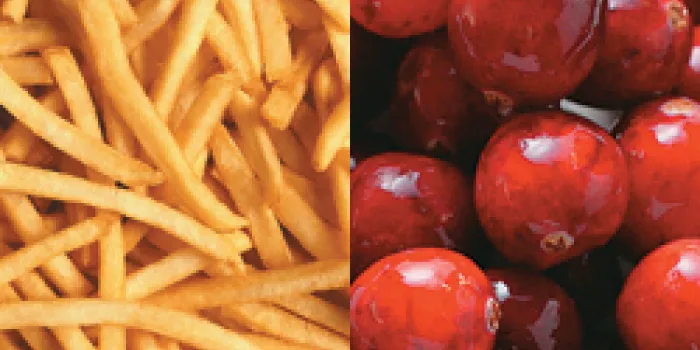Eating healthy is easier said than done, especially for people who are managing a chronic condition like a bleeding disorder. The stress of trying to keep up with a busy schedule can often lead to overeating, eating on the run and/or poor food choices. In our hurry-up lifestyle, zipping to a fast-food restaurant is often more convenient and less expensive than preparing a home-cooked meal. But when we eat out for lunch or dinner we have a tendency to consume larger portions and foods with more calories than we would normally eat.
[Steps for Living: Nutrition and Weight Management]
So how do these choices affect your health if you have hemophilia? Increased weight strains your joints and muscles, and can lead to further complications, including increased bleeds in susceptible joints. And during times of bleeds you are often more sedentary and not able to participate in appropriate exercise to burn those excess calories.
If you have a tendency to increase food consumption when you are inactive, this can add to the dilemma if you are already overweight or obese. The Centers for Disease Control and Prevention report teens and children with hemophilia are almost twice as likely to become overweight as the general population.
This means it’s more important than ever for patients with hemophilia to be eating a balanced diet and controlling portion size.
In addition, of particular concern is the predisposition of osteoarthritis (arthritis where there is loss of cartilage) in people with hemophilia after repeated episodes of bleeding into a joint.
Obesity causes and complicates osteoarthritis by increasing the mechanical stress on the cartilage within the joint. In fact, next to aging, obesity is the most powerful risk factor for osteoarthritis of the knees.
Gentle exercise usually does not aggravate osteoarthritis when it’s done at a level that does not cause joint pain.
And if those problems aren’t enough for people with bleeding disorders, the complications associated with obesity alone are serious.
According to the World Health Organization, there are 300 million obese adults worldwide and 18 million children are classified as overweight.
Obesity causes more that 300,000 potentially avoidable deaths each year. It contributes to heart disease, osteoarthritis, diabetes, stroke, hypertension, cancer and sleep apnea.
So what can you do to ensure that you are as healthy as you can be?
Exercise and proper nutrition must be incorporated into a healthy lifestyle plan in order for you to maintain a healthy weight.
Improving your nutrition and physical exercise program should begin with a visit to your physician to make sure you are able to endure physical activity with no health risks. Appropriate exercise should then be performed. Thirty minutes of exercise daily is recommended to maintain weight; 60 minutes per day to lose weight.
Gradual changes in eating habits, such as the ones mentioned here, are most likely to yield long-term results:
Be aware of portion sizes, read labels and avoid snack foods. Steer clear of foods that are high in fat and calories and offer little in the way of nutritional value. Be mindful of “hidden” or overlooked sources of excess calories, such as large glasses of juice and soft drinks.
Increase your consumption of fruits and vegetables. Dark, leafy greens and orange fruits and vegetables are excellent sources of vitamins and minerals. They are also a rich source of fiber, which helps you to “fill up” and maintain intestinal health.
Try to eat at least half of your grains from whole grain products. Try oats, barley, whole wheat, flax seed, bran, brown rice and pasta. Whole grains help to satiate the appetite, lower cholesterol and stabilize blood glucose levels to avoid an afternoon “slump.” Eat baked snack items instead of fried.
Use low-fat dairy sources such as 1% or skim milk and low-fat cheeses. These contain plenty of vitamins and minerals without the fats that have been linked to heart disease. (If you cannot consume milk, look for other sources of calcium, such as calcium-fortified orange juice.)
Bake, broil or grill lean meats, poultry and fish. Avoid heavy gravies, sauces and toppings that are often full of calories from fat. Include some meatless meals during the week by incorporating dried beans, nuts and seeds into your menus. Dried beans provide an excellent source of protein, and are high in fiber and low in fat, with no cholesterol. (Cholesterol is found only in animal-derived food sources, such as meats, eggs and milk.)
Reduce fat intake and increase the use of “good fats.” These include olive and canola oils. Limit the use of butter, stick margarine, shortening and lard.
A few other nutritional suggestions are especially important for people with hemophilia.
In addition to maintaining healthy weight, people with bleeding disorders need to maintain normal blood volume and blood cell production. There are several nutrients involved in blood cell production, such as: iron, protein, copper, vitamin C, vitamin B12, vitamin B6, vitamin E and folic acid.
But it would be wise for patients to avoid vitamin E supplements since they may increase the risk of bleeding. A diet that incorporates all of the food groups should provide nutrients adequately.
During a bleed, it is estimated that a miniscule amount of iron—roughly .75 micrograms—is lost with each tablespoon (15 ml) of blood. Maintain your iron levels by eating naturally iron-rich foods such as liver, lean red meat and poultry, all of which provide the best and most readily absorbed iron sources.
Other excellent sources of iron are leafy green vegetables, broccoli, dried beans, grains and raisins. Combining iron-rich foods with good sources of vitamin C (such as orange juice) can enhance iron absorption.
Being realistic, you know that you’re not going to make perfect choices at every meal, but it is important to make the effort to try to improve your diet.
It’s OK to indulge in a piece of cake at a birthday party, but don’t forget to eat lots of fresh vegetables at the next meal.
In other words, “Spend your calories as wisely as you would your money.”
Editor’s Note: Jennifer LaFranco is director of clinical programs at The Mary M. Gooley Hemophilia Center in Rochester, New York. Diane Delorm is the consulting clinical dietitian at the center.


 Keep portions small. Large portions are the biggest assault on good diet intentions, especially when ordering out. Avoid “biggie” combos or meal packages that entice you to overeat.
Keep portions small. Large portions are the biggest assault on good diet intentions, especially when ordering out. Avoid “biggie” combos or meal packages that entice you to overeat.